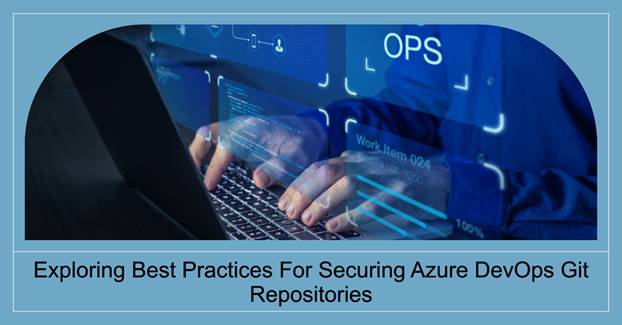Azure DevOps has become a prominent platform in the ever-changing world of software development. This robust platform encompasses various components, with Azure DevOps Git Repositories being particularly noteworthy. These repositories facilitate seamless collaboration among teams working on code projects.
Nonetheless, as the saying goes, great power brings great responsibility, and safeguarding your Git repositories is crucial for protecting your codebase and sensitive data.
This article will explore five essential practices for securing Azure DevOps Git Repositories. By implementing these measures, you can ensure the safety of your code while maintaining a smooth development process.
1. Implement Azure DevOps Backups
While securing your Azure DevOps Git Repositories, it is equally important to implement a robust backup strategy. Data loss can occur for various reasons, including accidental deletions, system failures, or even malicious actions.
Therefore, ensuring business continuity and safeguarding your codebase necessitates the implementation of Azure DevOps backups as a crucial step.

Azure DevOps offers a range of integrated tools and features designed to facilitate backup and recovery processes. Users can create regular backups of the Azure DevOps organization, encompassing essential elements such as Git repositories, work items, build pipelines, and more. These backups are securely stored in Azure Blob Storage, ensuring both durability and accessibility.
By implementing a robust backup strategy aligned with your organization’s recovery point objectives (RPO) and recovery time objectives (RTO), you can effectively safeguard your repositories and data against unforeseen disasters or potential data loss incidents.
Establishing reliable backup policies minimizes downtime risks while fortifying data protection measures.
2. Enforce Strong Password Policies and Two-Factor Authentication
Passwords are crucial for securing user accounts. It is essential to encourage the creation of strong and unique passwords while also implementing password policies that include requirements for complexity.
In Azure DevOps, users can establish password policies for their accounts, thus ensuring that weak passwords do not compromise the system’s overall security.
To enhance security, it is recommended to enable Two-Factor Authentication (2FA) for all user accounts. With 2FA, even if someone gains access to a user’s password, they cannot log in without the second authentication factor, typically a temporary code sent to their mobile device.
Azure DevOps provides multiple 2FA options like SMS, email, and authenticator apps. By requiring 2FA, the security of your Git repositories is significantly strengthened as unauthorized access becomes highly challenging.
3. Regularly Monitor and Audit Repository Activity
Maintaining the security of your Azure DevOps Git Repositories requires proactive monitoring and auditing. Azure DevOps offers comprehensive auditing capabilities that enable you to track all user and system activities related to your repositories. It is essential to establish alerts for suspicious activities like repeated failed login attempts or unusual access patterns.
Additionally, regular review of audit logs assists in promptly detecting and responding to potential security incidents.
To enhance the security of your repository, you can make use of Azure Monitor and Azure Security Center. These powerful tools offer comprehensive insights into your repository’s security. They are equipped with advanced threat detection capabilities that enable you to proactively identify and address potential security risks.
By continuously monitoring and auditing repository activity, you can effectively safeguard the integrity of your codebase and ensure protection against various threats.
4. Secure Your Build Pipelines
Build pipelines have a vital role in the software development process, and their security is equally essential to safeguarding Git repositories. Configuring your build agents and pipelines with the principle of least privilege is crucial. Only provide necessary permissions for accessing repositories, packages, and other resources.
Moreover, it is advisable to sign your build artifacts in order to ensure their authenticity and integrity. Azure DevOps offers built-in support for code signing and secure package management, making it easier for you to maintain trust in your deployment pipeline. Additionally, make sure to regularly update your build tools and dependencies to patch known vulnerabilities. It will effectively reduce the attack surface for potential exploits.
5. Keep Your Repositories and Tools Updated
One security measure that is often overlooked but crucial is to keep your Azure DevOps Git Repositories and associated tools up to date. Microsoft consistently releases security updates and patches for Azure DevOps, which should be promptly applied to address known vulnerabilities.
To ensure the security of your DevOps environment, it is essential not only to update Azure DevOps itself but also to keep all plugins, extensions, and third-party tools integrated with it up todate. Outdated software can pose significant risks as attackers often target known vulnerabilities.
6. Implement Continuous Security Scanning
In today’s ever-changing cybersecurity landscape, it is essential to go beyond static security measures and embrace a dynamic approach when securing your Azure DevOps Git Repositories. One proactive strategy that you should consider implementing is continuous security scanning. This approach involves regularly scanning your codebase and dependencies to identify vulnerabilities and threats.
Fortunately, numerous tools and services are available to assist you in this process,including Azure Security Center and third-party vulnerability scanners.

By incorporating these tools into Azure DevOps pipelines, developers can automatically scan their code for known security vulnerabilities and receive real-time feedback. This approach not only helps identify potential risks at an early stage but also enables prompt addressing of those risks.
Moreover, the ability to establish policies that prevent the deployment of code with critical vulnerabilities ensures that only secure code reaches production. Continuous security scanning plays a crucial role in a successful DevSecOps strategy, ensuring proactive mitigation of emerging threats and vulnerabilities while effectively safeguarding Git repositories.
Conclusion
Securing your Azure DevOps Git Repositories is an ongoing process that requires vigilance and a comprehensive approach. By implementing strong access controls, enforcing password policies and 2FA, monitoring and auditing repository activity, securing build pipelines, and keeping your repositories and tools updated, you can significantly enhance the security of your codebase and development process. These best practices are essential for safeguarding your organization’s intellectual property and ensuring the success of your software projects. Embrace these practices, and you’ll be well-equipped to securely navigate the dynamic landscape of modern software de securely.
